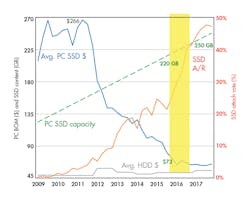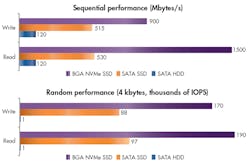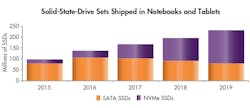Download this article in PDF format.
The evolution of digital storage over the past decade has been nothing short of stunning. Solid-state drives (SSDs) are at the center of what can be referred to as an industry-shifting transformation. Once limited to niche applications such as large-scale workstations and high-end gaming machines, SSDs are rapidly displacing hard-disk drives across the entire personal-computing spectrum. In a market seriously challenged by the continued push toward a highly mobile world, the need for greater innovation in PC design has never been more critical, with the industry’s storage response now being led by the minuscule ball-grid-array (BGA) SSD.
Behind the BGA
Designed using the densest three-dimensional (3D) Vertical NAND technology on the market, BGA SSD technology packs NAND flash, DRAM memory, and a controller chip into a package that weighs less than half a penny and is smaller than a postage stamp. Moreover, the performance of this tiny SSD powerhouse is up to 1,500 times that of a typical PC hard-disk drive (HDD).
When SSDs were first introduced to the market about 10 years ago for select ultra-mobile PCs and note PCs, they featured higher performance than HDDs, but at low capacities and relatively high prices. Since then, technological improvements such as 3D NAND and tri-level-cell (TLC) technology together have greatly increased the density of SSDs, sharply reduced their cost, and opened the door for much smaller form factors.
The 3D NAND process, which was introduced in 2013, stacks semiconductor cells vertically instead of cramming them onto a horizontal plane, therefore enabling much higher SSD densities while also lowering power consumption, boosting performance, and lengthening cell endurance. In addition, TLC designs raised the numbers of bits per NAND cell from two to three, requiring less semiconductor material for the same amount of data. The ability to realize TLC technology for 3D NAND has sped up market acceptance of higher SSD densities, increased performance, and provided greater reliability.
Strong Cost Competitiveness
The migration to 3D NAND and TLC technology has led to significantly higher SSD cost and performance competitiveness than single-level-cell (SLC) and multilevel-cell (MLC) NAND-based SSDs. It’s no coincidence that the industry is now adopting SSDs on a massive scale in notebook PCs. Figure 1 below shows the average SSD cost (~$73) and capacity (~220 GB) that triggered wide-scale SSD adoption in PCs. The primary x-axis shows PC SSD capacity, PC SSD cost, and PC HDD cost, while the secondary x-axis shows the corresponding SSD adoption rate in Notebook PCs.
1. The SSD attach rate in notebook PCs is compared against HDD cost, SSD cost, and SSD capacity. (Source: Forward Insights, Gartner)
Last year, 2016, was a transformative year for SSDs, with the attach rate in notebooks doubling from nearly 20% to 40%. Some analysts are predicting that nearly 50% of notebooks will ship with SSDs in 2017, signifying a major departure from the use of HDDs in consumer electronics. SSDs have many advantages over HDDs, including lower power consumption, better reliability, higher density, reduced physical size or “form factor,” and, of course, much greater performance. Let’s focus on the impact of the last two—form factor and performance.
Lightning Fast and Amazingly Small
When comparing SSDs and HDDs connected over the same SATA interface, SSDs can be nearly 100 times faster than HDDs. That’s due to the inherent benefits of using semiconductor technology to store data without any moving parts, rather than having to use spinning magnetic platters and a mechanical read/write head.
Furthermore, unlike the SATA interface and its underlying software that were originally designed for HDDs, a PCIe interface clearly broadens the solid-state advantage. Not only does a PCIe connection enable multiple lanes of data transfer at a faster rate per lane than SATA, it also utilizes the NVMe (Non-Volatile Memory Express) software protocol, designed from the ground up to maximize the speed of SSDs.
Regarding the physical form factor, both SSDs and HDDs are available in standard 2.5-in. drive casings. However, unlike HDDs, SSDs can be condensed into much smaller form factors. Due to the advent of 3D Vertical NAND and advanced TLC technologies, SSD densities have continued to scale. Equally as important, form factors have shrunk to a surprising degree. With more data per cell, and the ability to stack cells vertically, much higher solid-state densities are possible and less space is required on the circuit board to place the underlying NAND chips.
BGA SSD: Small Yet Powerful
The latest and most important SSD form-factor innovation is the BGA SSD, which is about five times smaller than an M.2 SSD and 100 times smaller than a 2.5 in. SSD or HDD. With dimensions of 20 × 16 × 1.5 mm, this tiny package consists of 16 3D NAND flash chips totaling 512 GB of storage capacity (the same as a typical PC HDD), as well as a mobile DRAM chip and high-performance controller. Transferring data over two PCIe 3.0 lanes, each at 8 Gb/s, means that 16 Gb/s of bandwidth is available instead of the 6 Gb/s used with SATA-connected devices such as HDDs.
Combining the PCIe interface with the flash-optimized NVMe protocol results in sequential read and write speeds of up to 1,500 MB/s (megabytes per second) and 900 MB/s, respectively, enabling the transfer of a 5-GB equivalent full HD movie in about three seconds, and full download in about six. Random read and write input/output operations per second (IOPS) for a BGA SSD are up to 190,000 and 170,000, respectively, enabling a seamless user experience on virtually any notebook. On the other hand, HDDs can only process up to 120 random read IOPS, meaning an NVMe BGA SSD is at least 1500 times faster.
Empowering a Power-Lean Generation
2. The bar chart compares the performance of the SATA HDD vs. SATA SSD vs. BGA NVMe SSD. (Source: Samsung)
Figure 2 shows the superior performance of the BGA NVMe SSD compared to SATA SSDs and SATA HDDs. Higher random performance (measured in K IOPS, or thousands of input/output operations per second) accelerates application launch times, user file access, and system boot-up. Higher sequential performance—measured in megabytes per second (MB/s)—sharply increases the data-transfer speed for processing data sets and moving information on and off a PC.
Consider another key performance barometer of notebooks: device battery life. From a pure device perspective, SSD power consumption is cut in half to approximately 3 W when moving from an M.2 PCIe NVMe SSD to a BGA PCIe NVMe SSD, a major design consideration for the next generation of notebooks.
Shot in the Arm for PCs
The PC market has been weak for several years, considering the expansion of the smartphone market and the rise of the tablet. While smartphones and tablets historically have utilized mobile memory technologies that enable compact physical designs, they simply can’t deliver the high performance and densities associated with today’s PCIe NVMe SSDs. Consumer demand is growing for mobile PCs that not only provide “instant on” and “anywhere, anytime” connectivity, but also offer the best storage performance on the market, with capacities that meet or exceed that of HDDs.
3. Here’s a look at the solid-state drive sets shipped in notebooks and tablets, and projections for the next couple of years. (Source: Forward Insights)
While M.2 SSDs opened the door to new mobile PC designs, BGA SSDs are taking this efficiency a great deal further, as solid-state technology further blurs the lines between notebooks and mobile devices. Because many notebooks already incorporate NVMe SSDs into new designs (Fig. 3), and the BGA NVMe SSD uses the same underlying software as the M.2 form factor, the PC ecosystem is ready for BGA SSDs with virtually no added design requirements. Fig. 3 shows the projected growth of SSDs in notebook and tablet applications over the next several years.
Unsurprisingly, most SSD growth is likely to be in NVMe-based SSDs. Expect BGA NVMe SSDs to break out soon within this segment, leading to new cutting-edge notebook and other mobile PC designs.
About the Author
Anders Graham
SSD Product Marketing Manager
Anders Graham is SSD Product Marketing Manager at Samsung Semiconductor Inc., where he focuses on SSDs and their impact on customer systems and infrastructure. He is responsible for marketing SSDs used in both PC and enterprise applications.




